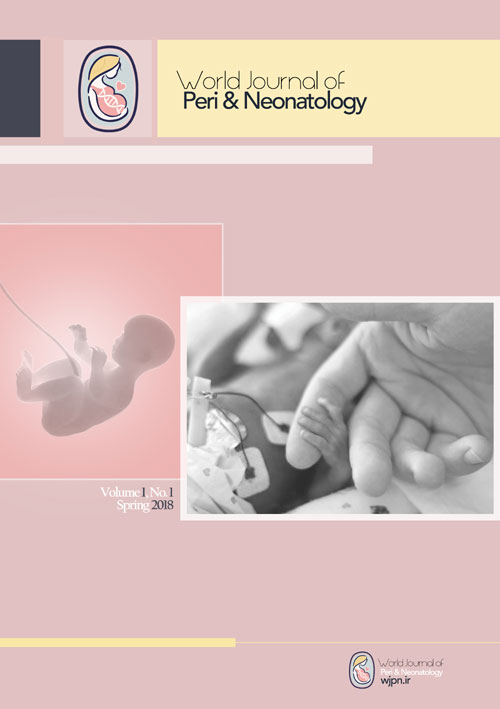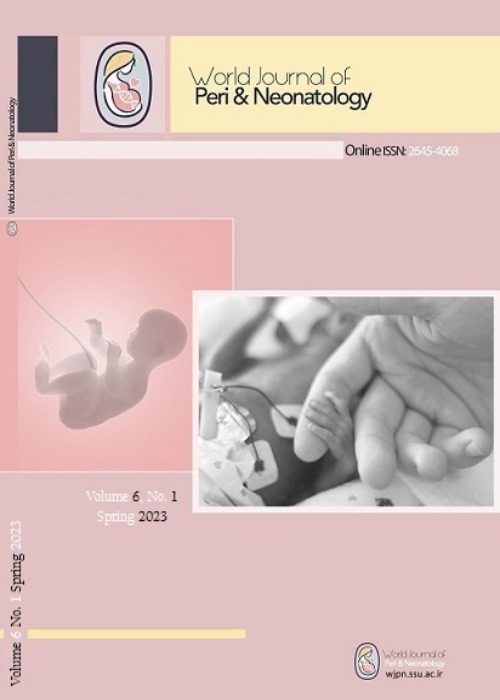فهرست مطالب

Journal of World Journal of Peri and Neonatology
Volume:1 Issue: 1, Summer - Autumn 2018
- تاریخ انتشار: 1397/06/13
- تعداد عناوین: 8
-
Pages 1-6Background
A few studies have been conducted to explore the association of MTHFR A1298C (rs1801131) polymorphism with preterm birth risk, the results remain inconsistent. Therefore, we conducted a meta-analysis to derive a more systematic estimation of the association.
MethodRelevant studies were searched by PubMed, EMBASE, CNKI, and Google Scholar up to June 2018. The strength of the association of MTHFR A1298C polymorphism with preterm birth was calculated by odds ratios (OR) with 95% confidence interval (95%CI).
ResultsA total of nine case-control studies with 1,609 cases and 14,981 controls were included. Pooled results showedthat there was no significant association between MTHFR A1298C polymorphism and preterm birth risk under all five genetic models in overall. However, in the stratified analysis of ethnicity, a significant association between MTHFR A1298C polymorphism and preterm birth risk was observed in the Asians under four genetic models, i.e., allele (C vs. A: OR=0.960, 95% CI 0.543-0.871, P =0.002), heterozygote (CA vs. AA: OR=0.887, 95% CI 0.024-0.457, P =0.003), dominant (CC+CA vs. AA: OR=0.965, 95% CI 0.534 -0.935, P =0.015) and recessive (CC vs. CA+AA: OR=0.923, 95% CI 0.026-0491,P =0.004), but not in Caucasians.
ConclusionThis meta-analysis suggested that MTHFR A1298C polymorphism is not associated with preterm birth risk in overall population. However, MTHFR A1298C polymorphism plays an important role in preterm birth development in Asian population.
Keywords: PretermBirth, MTHFRGene, Polymorphism, Meta-analysisMeta-Analysishttp:, wjpn.ir -
Pages 7-14Background
Congenital anomalies are conditions of prenatal origin that arepresent at birth, potentially impacting an infant's health, development and survival. The birth of a newborn with congenital anomalies imposes financial and emotional burdens on families. The aim of this study was to investigate the epidemiology of congenital anomalies in 2014 in Zabol, Iran.
MethodsThis cross-sectional study was carried out in the AmirAl-Momenin Hospital between May of 2013 and April 2014. All the live born were included, and we have examined all newborns for the presence of congenital anomalies.
ResultsDuring the twelve months, 9,309 newbornswere included to the study. Of them,72 (0.8%) newborns were affected with a congenital malformation. The congenital anomalies affected significantly higher proportion of male newborns(66.7%) than female newborns (33.3%).Among Of them, musculoskeletal system abnormalities account for 45.9% of the total abnormalities allocating the highest frequency to itself. Subsequently, central nervous system abnormality (19.4%), gastrointestinal anomaly (15.3%), urinary tract abnormality (9.7%), chromosomal abnormality (2.8%), and multiple anomalies (1.4%) were frequent, respectively.
ConclusionThis study showed that prevalence of congenital anomalies isrelativelyhigh in Zabol city.The results of this study identify the necessity ofgenetic counseling and early diagnosisto prevention, care and surveillance.
Keywords: Congenital anomaly, Chromosomal abnormality, Prenatal, Counseling -
Pages 15-20Background
The aim of this study was to determine the relationship between ages above 35 years old and gestational diabetes mellitus in Zabol.
MethodsThis study was conducted in Zabol city during 2016-2017. Analyzing the data to check the validity of the hypothesis in any type of research is of particular importance and is performed nowadays in most research studies based on the data gathered from the subjects under study. Data analysis is one of the main and most important parts of any research. Raw data is analyzed using statistical software.
ResultsThe results of this study showed that according to the gestational diabetes mellitus score of 150 mothers, about gestational diabetes, 11 cases (7.3%) had gestational diabetes, and 132 (92.7%) others have not experienced gestational diabetes. Generally, according to the average score (1.92), there is no gestational diabetes in mothers.
ConclusionThe most important risk factors for gestational diabetes are age, obesity and familial history, respectively.
Keywords: Gestational diabetes, Age, Pregnant women, Obesity, Zabol -
Pages 21-29Background
In recent decades, extended spectrum beta-lactamase (ESBL) generating bacteria have increased universally. Among the most important causative agents of nosocomial infectionsthroughout the world, Escherichia coli as main ESBL-producing bacteria are so highly regarded. Trends in the treatment of infections by such bacteria have led to a global concern.
MethodsAll strains were cultured and identified by the Clinical Microbiology Laboratory and were recovered from blood and urine cultures. In-vitropresence of ESBL was confirmed with Clinical and Laboratory Standard Institute double disc and PCR for CTX-M1, CTM-M2, and CTX-M3 method.
ResultsThe results of this study showed that Escherichia coli samples were resistant to AN (42.85%), GM (28.57%), AM (35.71%), AMC (35.71%), CZ (35.71%), and AZM (50%) antibiotics. While the most susceptible to antibiotic was ampicillin (64.28%), the least resistance to antibiotics was gentamicin.
ConclusionThe current situation of multiple bacterial antibiotic resistanceshas become a worrisome issue in UTI. Multi-drug-resistant E. colican be readily encountered in hospital settings during daily clinical practice, and urologist should act timely. The management of such infections is extremely important for the future, with particular reference to prevention of new antibiotic resistance patterns.
Keywords: Beta-Lactamase, Pregnant Woman, E.Coli, CTXgeneOriginal Articlehttp:, wjpn.ir -
Pages 30-35Background
The extent of the contribution of rs642961 polymorphism of interferon regulatory factor-6 (IRF6) gene with susceptibility to the syndromic cleft lip with or without cleft palate (NSCL/P) in the Iranian patients is still unknown. Thus, to test the role of IRF6 in NSCL/P susceptibility in an Iranian population, we performed a population based case-control stud.
MethodsOne-hundred ten patients with NSCL/P and 110 matched healthy subjects were recruited to this population-based study. The IRF6rs642961 polymorphism was genotyped by polymerase chain reaction-restriction fragment lengthpolymorphism(PCR-RFLP) assay.
ResultsParticipants did not differ significantly by age and gender (P > 0.05). The AA, AG, and GG genotypes frequencies of the IRF6rs642961 polymorphism in the NSCL/P cases were 27.3%, 53.6% and 19.1%, respectively while the corresponding frequencies in the healthy subjects were 34.5, 56.4% and 9.1%, respectively. There was a significant association between homozygote mutant genotype (GG) of IRF6rs642961 polymorphism and increased risk of NSCL/P (OR = 2.360, 95% CI 1.055-5.280, P = 0.037).
Conclusionthe current study suggested that IRF6rs642961 polymorphism might be associated with susceptibility to NSCL/P in an Iranian population. However,well-designed epidemiological studies with larger sample size are needed to further validate our results.
Keywords: Nonsyndromic, Cleft lip, Cleft palate, Interferon regulatory factor 6, Polymorphism -
Pages 36-47Background
Today there aremany diseases that genetics contributes to these, including diabetes, hypertension, cancer, heart disease, various types of cancers and even mental illness, and by the advancement of medical knowledge The number of genetic diseases is increasing now. mostpeople think about genetic diseases as inherited diseases,which are mostly caused by genemutations and other genetically inherited factors.Most of the genetic disorders currently do not have 100% treatment, and the only way istopreventing the prevalence of them before marriage.
MethodsEligible articles were identified by search of databases includingNCBI,PubMed, ISI Web of Knowledge and Google scholar up to July2017.
ResultsIn the field of prevention of disability and genetic disorders, many members who are at risk of genetic disease should have genetic counseling to get useful information about it. Without genetic counseling, genetic testing is meaningless, as people do not go to the laboratory without a doctor's visit; Genetic counselorswon’t be able tostop people from getting married, but they provide solutions to prevent them frompossibledisorders.
ConclusionsThis study provides information on genetic diseases and preventsthem in newborns and suggests new solutions for the treatment of these diseases
Keywords: Gnetic, Pre-implantation Dagnosis, Genetic counseling, Congenital -
Pages 48-55Background
With the recent development of CRISPR/Cas9 genome editing technology, the possibility to genetically influence the human germline (gametes and embryos) has become a separate technical possibility.As a powerful skill for genome engineering, the CRISPR/Cas9system has been effectively applied to adjust the genomes of several species. The purpose of this review was to appraise the technology and build concepts for the launch of precise hereditary modifications in early human embryos.
MethodsWe conducted a systematic review of the related literatures searched from PubMed, Google scholar, Web of Science up to June 30, 2017 and then we extracted the essential data. In this review, we present the brief history and basic mechanisms of the CRISPR/Cas9 system and significant challenges and advances in the field as a comprehensive practical guide to absorbed users of genome editing technologies. We introduce factors that influence CRISPR/Cas9 efficacy which must be addressed before effectiveinvivohuman embryo therapy can be realized .in this review, we highlight the advancements that have been made using CRISPR/Cas9 in relation to Human Embryo.Results and
ConclusionThe possibility of CRISPR/Cas9 use in the context of human reproduction, to change embryos, germline cells, and pluripotent stem cells are studied created on the writers' expert belief. We discuss recent developments leading to the operation of Human Embryonic gene therapies in clinical trials and consider the predictions for future advances in this rapidly developing field.
Keywords: Gene editing, Gene therapy, Development, Embryo, Reproduction -
Pages 56-58Background
Farber disease is a very rare autosomal recessive disease of lipid metabolism caused by deficient activity of lysosomal acid ceramidase. Symptoms can begin in the first year of life by a triad of painful and swollen joints and subcutaneous nodules, progressive hoarseness and variable central nervous system involvement.
Case ReportA5 monthsold girl with subcutaneous nodules in limbs, pain and swelling in her fingers, Knees, elbow and hoarseness was referredto our clinic. She had neurodevelopment delay in walking and talking. Genetic analysiswas reported homozygosity for a c.830C>A mutation in exon 11 of N-Acylsphingosine Amidohydrolase 1 (ASAH1)gene. She diagnosed with Farber disease and treated with bone marrow transplantation. After that her signs and symptoms were improved and she could to walk.
ConclusionFarber disease is associated with characteristics including swollen joints, subcutaneous nodules, progressive hoarseness and variable CNS involvement. Moreover, bone marrow transplantation improved these symptoms.
Keywords: Farber disease, Bone marrow transplantation, CNS involvement


